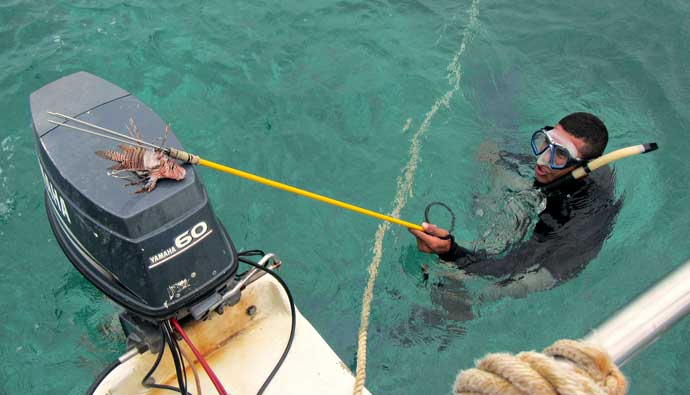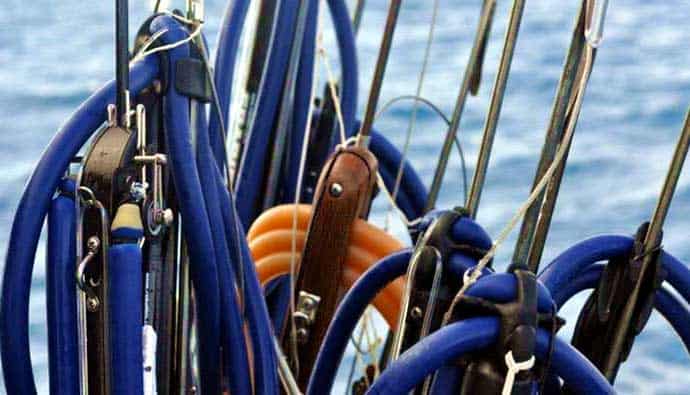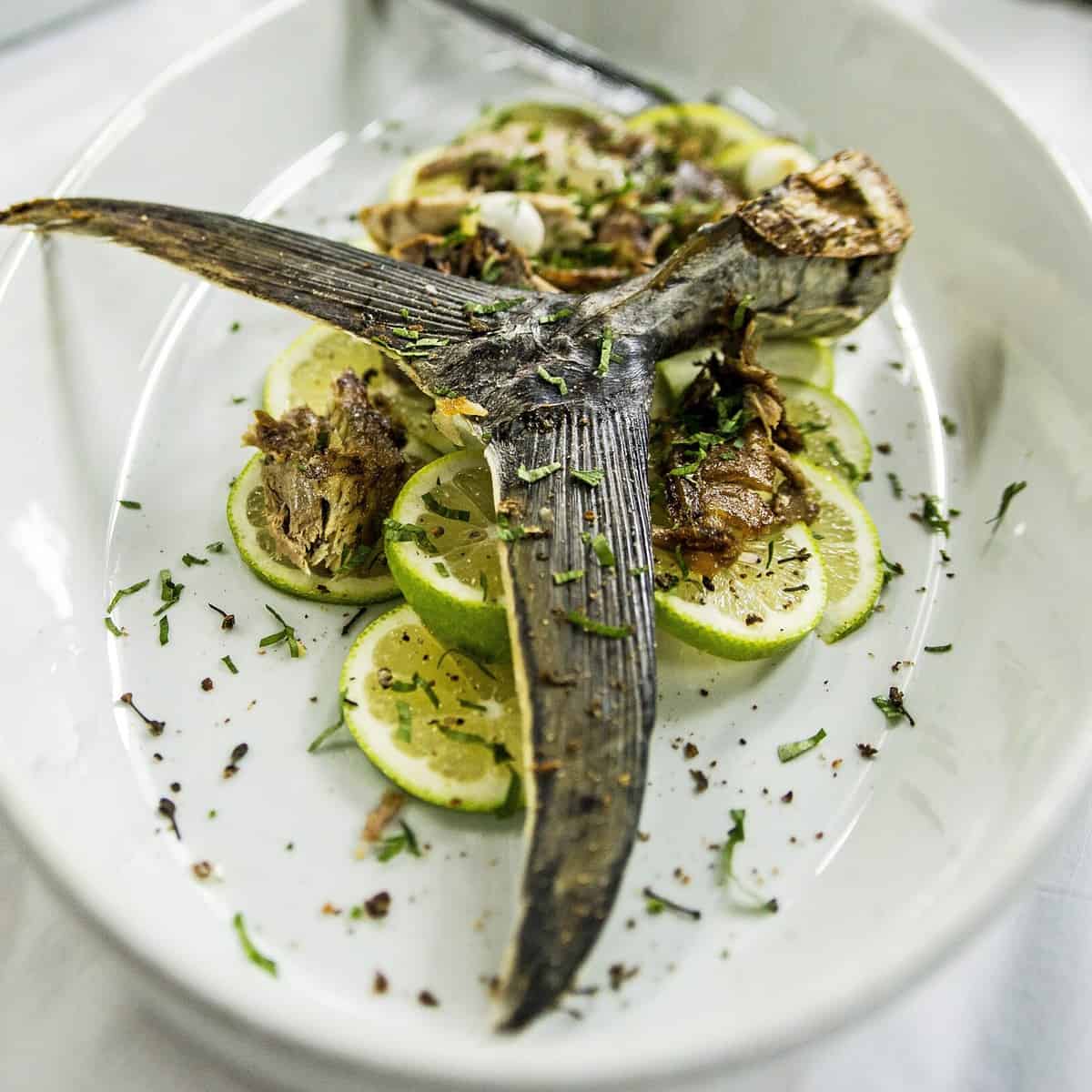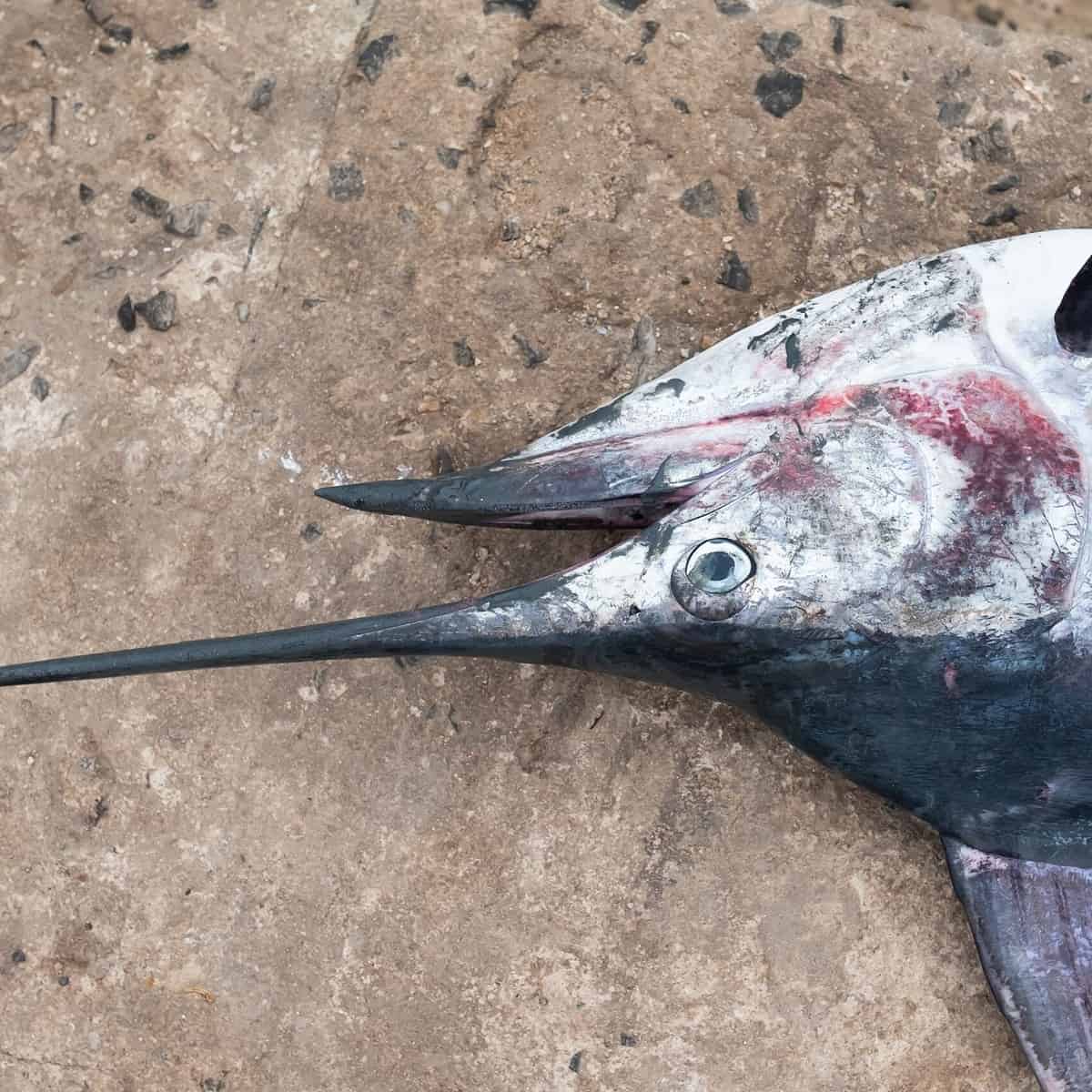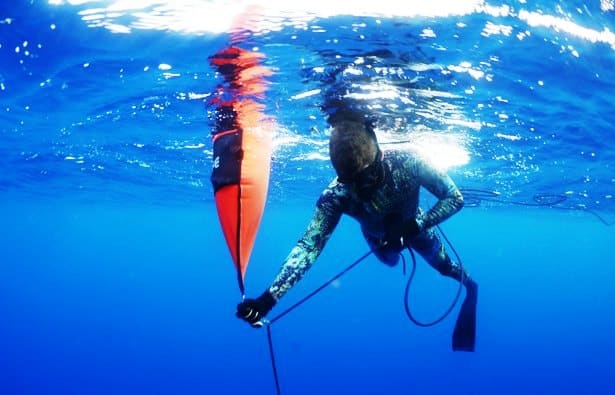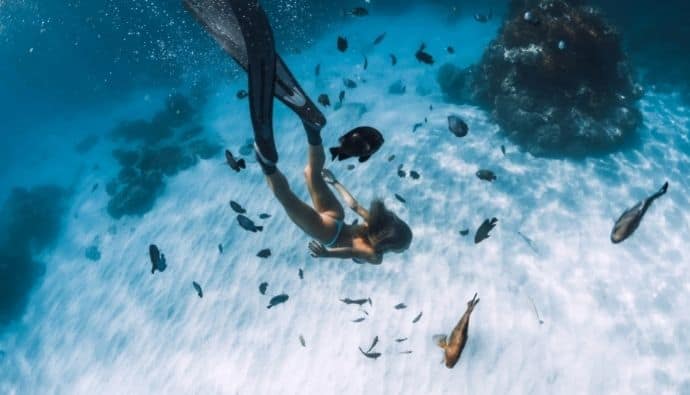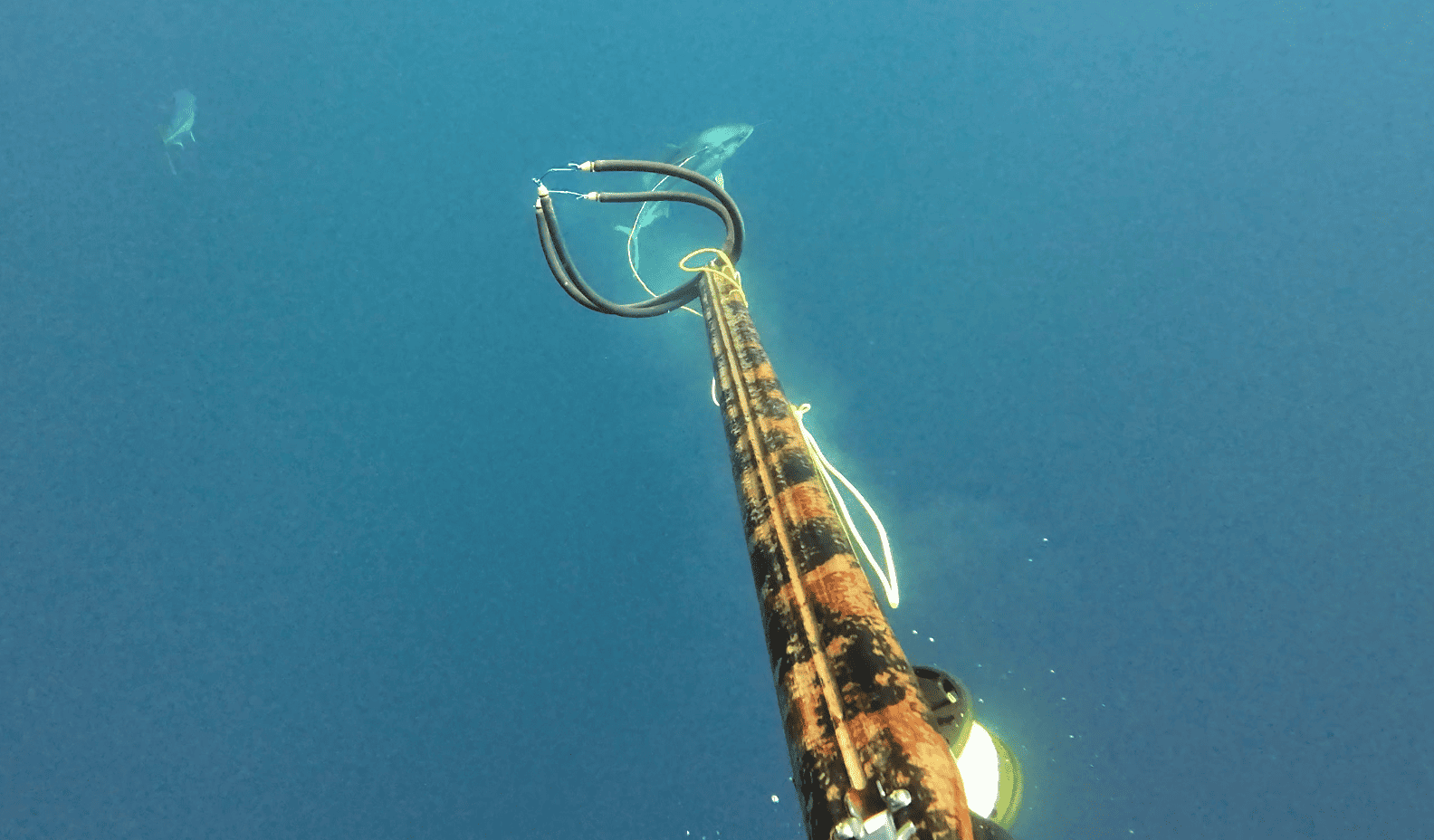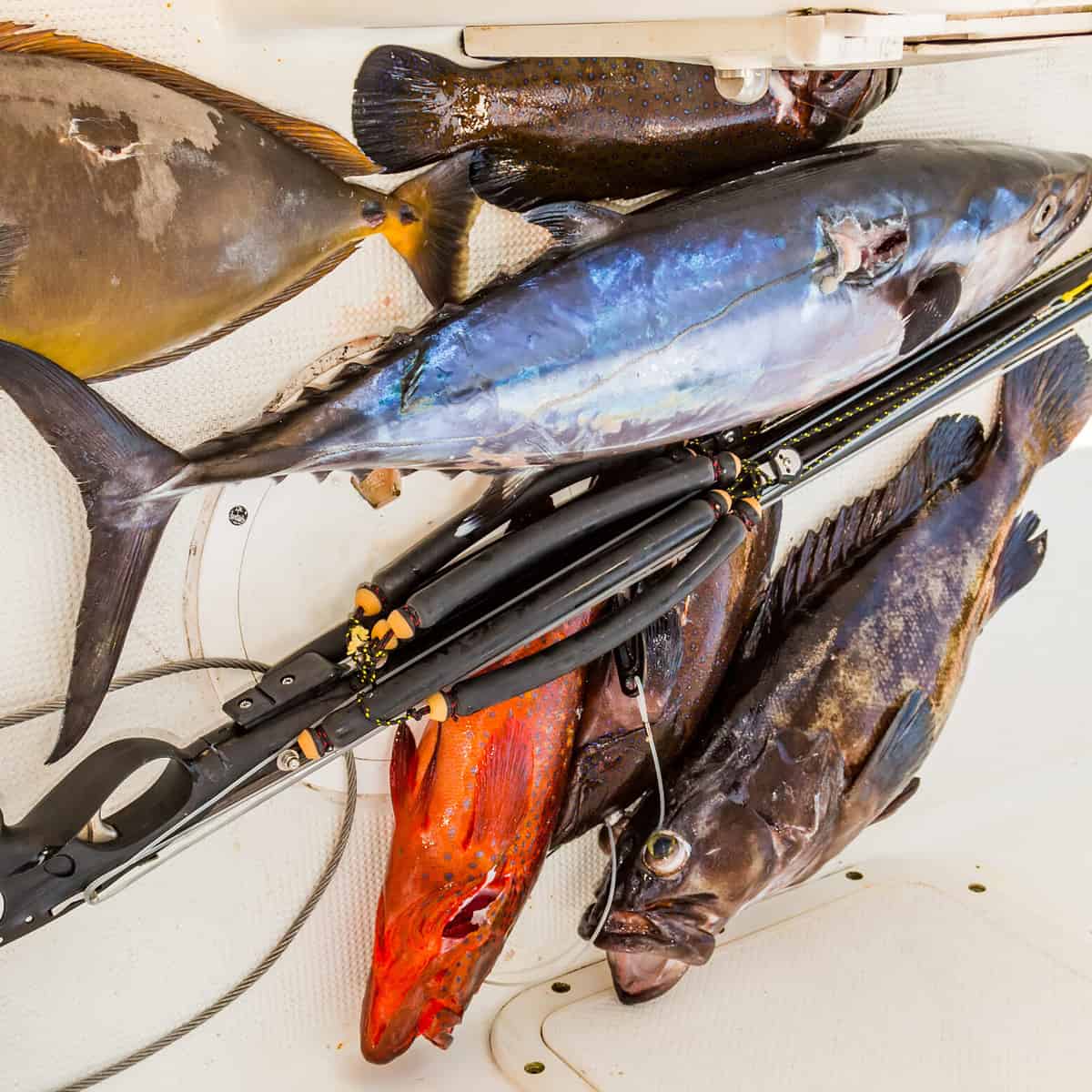Shallow water blackout happen when your brain is starved of oxygen. It’s a defense mechanism of the body. Similar to when a person faints on land, this could happen while you’re underwater. Typically due to your mammalian dive reflex, you have a certain amount of time before brain damage can occur. If no one is there to expose your mouth and nose to oxygen, the person will have their terminal breath and allow water into their lungs causing them to drown.
When I first started spearfishing I saved my buddy’s life from a shallow water blackout. We were spearfishing off the oil rigs in Long Beach when his line got tangled and he started panicking. Luckily, I was watching the whole thing unfold and was able to grab him before he sank 200 feet to the bottom of the ocean.
Far too many spearos over the years have succumbed to death by drowning due to shallow water blackout.
It’s important to remember that this can be prevented if you always dive with a buddy, have a dive knife, and refrain from controversial dive practices such as hyperventilating before your dive and diving past your limits.
In order to better understand what causes shallow water blackout, we’ve dug up an old article by David Sipperly called, “A Closer Look at Shallow Water Blackout.” We’ve turned this article into a comprehensive guide for understanding what causes shallow water blackout and shallow water blackout prevention.
This is important reading for all spearos and freedivers.

What is a Shallow Water Blackout?
Shallow water blackout, also known as fainting or losing consciousness underwater, results from cerebral hypoxia or reduced oxygen supply.
There’s no telling when someone is going to have a shallow water blackout. Some divers can go decades before having their first one. That’s why it’s always important to dive with a buddy, even if you’re a seasoned diver.
Fainting in the water may result in injury or, worse, death. Those who survived losing consciousness underwater describe mixed feelings of pain, confusion, and the urge to exert physical effort. On the other hand, no signs of struggle were seen for those who drowned due to a shallow water blackout.
Whether you’re swimming in your family’s swimming pool, the ocean, lake, river, or even in your bathtub, you are susceptible to shallow water blackout. Those who experienced it usually perform underwater distance swimming and those who engage in prolonged breath holding contests.
Shallow Water Blackout Safety
Now that freediving and spearfishing are becoming more popular thanks to YouTube and Instagram showcasing the wild world of underwater hunting and prolonged breath holding, it’s important we take a step back and educate ourselves on the risks and hazards associated with freediving.
If you’re a new spearo, you probably want to throw on your wetsuit, fins, mask, weight belt, and grab your speargun, and hit the water…
Shallow water blackout is one of the most dangerous aspects of freediving. BECAUSE YOU DON’T KNOW WHEN IT HAPPENS. One second you’re diving like normal. The next you’re either dead or your buddy is waking you up at the surface. Divers who use controversial techniques such as hyperventilation or pushing their limits of depth or time should know that it’s only a matter of time before something bad happens.
Who is Susceptible to Shallow Water Blackout
Shallow water blackout can occur to anyone. Just because you tell yourself that you’re super fit or have held your breath for long durations underwater already, doesn’t mean it won’t happen to you.
Advanced divers are actually more at risk because they tend to push their limits considerably more than novice divers. Novice divers will get the urge to come up for air much earlier than experienced divers keeping them safe.
What Causes Shallow Water Blackout: How It Happens
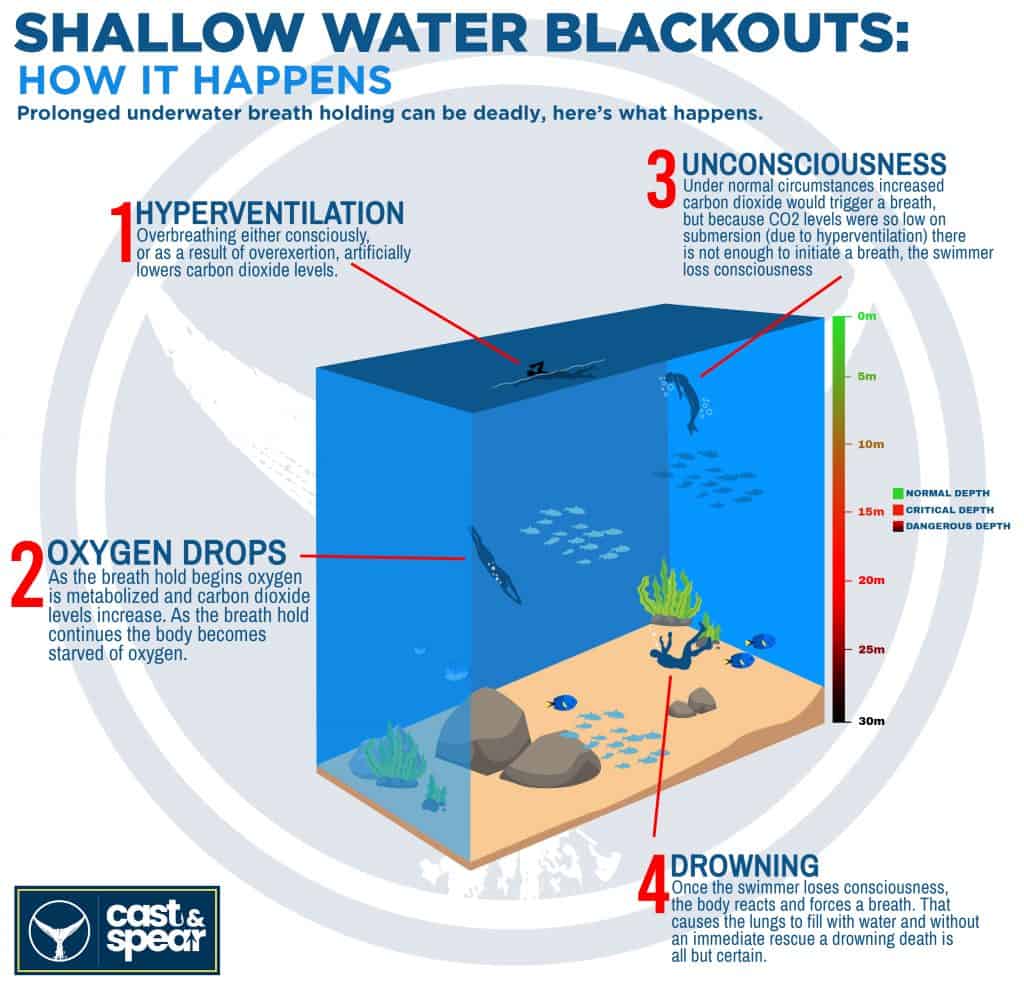
In our normal breathing process, carbon dioxide is important because it triggers the mechanism that tells our body to breathe.
It is not the lack of oxygen, but the rise of carbon dioxide that is monitored by chemoreceptors that signal our brain when to breathe.
This rise of carbon dioxide point is often referred to as the “breaking point.”
Most divers are familiar with the characteristics of oxygen. It is colorless, odorless, tasteless, and is normally found in the air at approximately 21 percent by volume and can be expressed as .21 atmospheres absolute (ATA) at sea level.
Most people can maintain proper blood oxygenation down to 16 percent (or .16 ATA), but this is becoming hypoxic. When the oxygen level drops to about 10 percent (or .10 ATA), unconsciousness results.
The following summarizes the signs and symptoms of hypoxia:
| Oxygen Percentage | Signs & Symptoms @ Sea Level |
| 15-19% | Rapid breathing, impaired judgment, dizziness, headache, fatigue. |
| 12-14% | Respiration increases, increased pulse rate, impaired coordination, perception, fatigue |
| 10-12% | Mental failure, unconsciousness, cyanosis, nausea. |
| 6-8% | 8 minutes, 100% fatal, 6 minutes 50% fatal, 4 minutes – recovery with treatment. |
Hyperventilation
Many breath-hold divers reach depths of 80-100 feet or deeper, with bottom times up to and well over two minutes by hyperventilating.
Hyperventilation is the increase of breathing rate and/or volume to fill the lungs with air while lowering the amount of carbon dioxide in the lungs.
If we “blow off” the carbon dioxide within our bodies, we can increase the time prior to the breaking point. Meanwhile, carbon dioxide is constantly produced as oxygen is constantly consumed by the body’s metabolism.
The most dangerous time is during the ascent. As the diver ascends, the volume of the lungs increases (according to Boyles Law), causing a drop in the partial pressure of the carbon dioxide and the stimulus to breathe.
At the same time, the partial pressure of oxygen also drops and is so low that the diver passes out before the urge to breathe is felt and/or the surface is reached. Typically, the shallow water blackout occurs around 10-15 feet from the surface (hence the name “shallow water blackout”).
This is the reason why all international training agencies such as NAUI, PADI, YMCA, TDI, etc., consider hyperventilation unsafe if more than three breaths are used. Once unconsciousness occurs, drowning is usually the end result.
Falling Into Unconsciousness
Unconsciousness is the body’s defense mechanism – it completely shuts down to help protect the brain. With the regaining of consciousness, there is a reflex to once again breathe, and the victim does so, but only to asphyxiate on seawater.
It is therefore imperative to get the victim to the surface as quickly as possible and attempt resuscitation efforts.
Shallow Water Blackout Signs & Symptoms
Some divers may experience some signs and symptoms of shallow water blackout such as dizziness, lightheadedness, tunnel vision, the sensation of heat, or a sense of euphoria.
Most commonly, there are no signs or symptoms or stimulus to breathe except unconsciousness (according to divers who were successfully rescued from shallow water blackout).
During unconsciousness, a diver may continue to kick or swim because the muscles in the extremities have the ability to function anaerobically. A typical diver may start a dive with 9 percent of lactic acid already in the extremities, but after a one-minute breath-hold dive to 90 feet of seawater, that could rise to 55 percent.
It is therefore important for dive buddies to note the attitude or angle of the diver coming up from depth and not just whether they are kicking. An unconscious diver will veer off to one side or start to sink back down toward the bottom.
Shallow Water Blackout Prevention
Here’s how to prevent shallow water blackout.
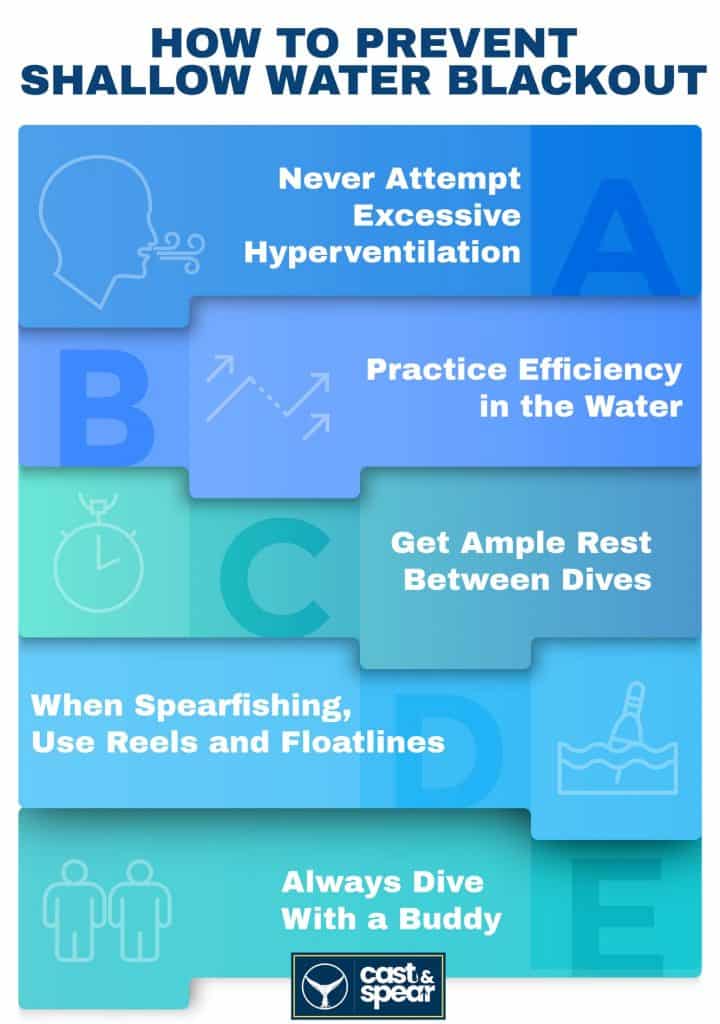
Never Attempt Excessive Hyperventilation
Keep it to three or four breaths. Try deep, slow relaxation-type breathing as used in yoga, instead of hyperventilation. The ability to relax is one of the most important aspects of prolonged breath holding.
Weighting is very important, yet also controversial. The best approach to help a shallow water blackout occurrence is to weigh oneself in order to be buoyant the first 10-15 feet.
This means that the diver is floating at the surface effortlessly after maximum exhalation. This positive buoyancy will assist the diver during the ascent, and an unconscious body will hopefully float to the surface instead of sinking back down to depth.
Both cases are bad, but it is much easier to find a victim at the surface than it is at depth.
The last thing we want is a double or triple fatality catastrophe to the other freedivers over-extending their abilities to recover a body. It is also wise to carry complete scuba gear on the boat whenever possible.
Practice Efficiency in the Water
Prolonged breath holding time is ultimately dependent upon the oxygen contained in the last breath we take at the surface. Therefore, we want to limit the consumption of oxygen as much as possible.
This means we must move underwater effortlessly and efficiently. Every action must have a reason or else it will waste precious oxygen. Do a breath holding training before diving into the water.
Remember that all body movements require oxygen and that thigh muscles are one of the largest groups of muscles; therefore, they require more oxygen than most other muscles.
Glide or pull yourself whenever possible. By keeping your drag down and your swimming profile sleek, you will be maximizing the distance covered per effort.
Get Ample Rest Between Dives
Resting between dives is equally important. Divers must rest and continue to breathe slowly and deeply to properly flush out the wastes and lactic acid that has accumulated in our bodies from the previous dive and to prep our body for the next dive. This takes time.
The general rule here is to rest at least two times the total time spent underwater. For example, if you just completed a one-minute and thirty-second dive at 60 feet of seawater, then you must spend three minutes at the surface before your next dive.
Violating this rule will only penalize you during your next dive. As experience and fitness progress, this surface time may be shortened.
Excessive exercise at depth, such as struggling with a fish or fighting a strong current can be deadly to the freediver as Terry Maas points out in his book, “Bluewater Hunting and Free Diving.”
When Spearfishing, Use Reels And Floatlines
Use reels and floatlines when spearfishing to let the fish tire themselves out instead of fighting them.
If the fish “holes up,” buoy the spot and come back later after the fish has died. An unfortunate example occurred in the 1985 U.S. National Championships when the defending national champion Phil Wisnewski* drowned after attempting to free a large fish from deep water in a moderate current.
Many other free divers have died from shallow water blackout since Phil’s death in 1985. Most of them occurred from shooting big fish in deep water without having a dive buddy helping them or using scuba to get the fish. Also, most of them were advanced freedivers and spearfishermen.
Always Dive With a Buddy
My last piece of advice is to dive and train with a buddy. If the visibility permits, divers should alternate dives, keeping a close eye on each other, especially when it is deep.
Deep is a relative term here. It may be 50 feet of seawater for some and 80 feet of seawater for others.
I consider a dive to be deep if it is at a depth where that little bit of apprehension comes into mind and I constantly keep checking my body for comfort.
In deep water, we often use one spear gun with a floatline and two divers. The diver on the surface works the floatline and is ready to fight the fish while the diver below can surface without excessive effort.
If anyone is holding their breath for more than two minutes, then it is my belief that there should be a dive buddy to supervise and help you. Unsupervised breath holding often leads to drowning.
Al Schneppershoff’s Thoughts on Shallow Water Blackout
Al states, “over the years of my diving experience, most of the fish that I have speared have been in less than 40 feet of water. And a good portion of them has been speared in less than 20 feet of water.”
You don’t have to be a deep diver to spear big fish. My 72-pound White Sea Bass was taken in 10 feet of water (the bottom was 20 feet down).
Most of the Yellowtail that I have speared have been in the top 20 feet of the water.
I have to say that I’ve never been one to push the envelope. Maybe this is because I have lost so many friends to shallow water blackout. It is just not worth it. No fish is worth it, no amount of deep diving is worth it.
It is not about the depth of diving, it is about the fish you catch. And you will spearfish with the proper skill and fish sense. Diving deep is completely unnecessary.
In all cases, it is better to be safe than sorry. Always be aware – aware of your limits, aware of who is around you (including boats), etc. Be aware of the time and how long you are in the water and pace yourself. Also, keep in mind that breath-holding may stimulate genetic triggers leading to various causes of death.
To be clear: The longer you hold your breath, you should have more surface time before each dive.
It bears repeating, especially for a beginner: You should always dive with a buddy who has more experience than you.
If you want to become a better freediver, then I recommend you take a freediving course from a certified freediving organization.
“Safety First.”
Frequently Asked Questions
Drowning can happen to anyone at any time, whether it’s in your family’s swimming pool or the ocean. It’s also a sensitive topic because most of the time those who are found in the water don’t regain consciousness.
The most important thing to note is that if you have the proper safety measures, drowning should be a low-probability event. That means having supervision with a lifeguard or dive buddy at all times and never pushing yourself past your limits.
Your ego is the most dangerous enemy to your good judgment.
What is drowning like? This guy does a great job explaining his experience. We’re all glad to see he’s ok!
It can be depending on how aware you are of what’s happening. If you find yourself in a shallow water blackout then you’ll be unconscious when your body inhales water making it less painful than if you were conscious.
When you’re conscious and your body is forced to inhale and takes in water instead of air, you’ll try to cough up the water or swallow it taking in more water involuntarily. Eventually, you’ll experience laryngospasm which protects your lungs from taking in more water, however, the water will be directed to your stomach.
Eventually, you’ll start feeling drowsy and you’ll start to sink in the water until you come to rest.
You have a short window to have someone perform CPR to help remove the water from your lungs and get your body breathing again. The window is short if you want to prevent permanent brain damage.
There are many different accounts of near-drowning experiences, some ranging from the feeling of lava to some saying that they breathed in willingly knowing their end was near and that it wasn’t painful.
Here’s an account of someone who survived a near-drowning experience:
I’ve nearly drowned at least once. Depending on the person, it’s either peaceful if you accept the fact that you’re probably gonna die (which I did) or it’s brutal as you struggle.
I actually realized that I was going to drown so I breathed the water in on purpose to just get it over with. It only hurt when I was coughing it up.
– Redditor /u/Dr4k399





 Facebook
Facebook YouTube
YouTube